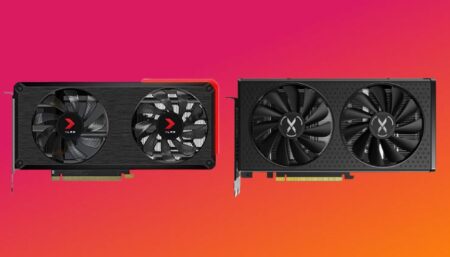![How to update GPU Drivers Windows 11? [Auto & Manual]](https://www.ingameloop.com/wp-content/uploads/How-to-Update-GPU-Drivers-Windows-11.jpg)
- Updating GPU drivers on Windows 11 is crucial for improving performance, stability, and compatibility with the latest games and applications.
- There are two methods to update GPU drivers: automatic and manual. Automatic updates can be done through the manufacturer’s website or software, while manual updates require downloading and installing the driver manually.
- Automatic updating involves accessing the Device Manager, selecting the graphics card, and allowing Windows to search and install any available updates.
- Manual updating requires visiting the manufacturer’s website, finding the appropriate driver for your specific graphics card and Windows 11, downloading the file, and following the installation instructions.
- Keeping GPU drivers and other system drivers up to date is recommended for optimal computer performance, system stability, and resolving various issues that may arise.
Updating your GPU drivers on Windows 11 is essential in ensuring that your graphics card is running at its best performance and is compatible with the latest games and applications. This guide will walk you through two ways to update your GPU drivers on Windows 11. Whether you’re a gamer, a designer or just someone who wants to ensure their computer runs smoothly, this guide will help you update your GPU drivers and get the most out of your graphics card. Let’s learn!
Key Takeaways
- Updating your GPU drivers can improve your gaming performance, fix bugs and glitches, and enable new features and compatibility.
- You can update your GPU drivers manually or automatically, depending on your preference and convenience.
- To update your GPU drivers manually, you need to identify your GPU model and manufacturer, download the latest driver from their website, and install it on your PC.
- To update your GPU drivers automatically, you can use Windows Update, Device Manager, or third-party software such as Driver Booster or Driver Easy.
- You should always backup your data and create a restore point before updating your GPU drivers, in case something goes wrong or you need to roll back.
How to update your GPU drivers on Windows 11?
Updating the GPU drivers is crucial because it can help improve the performance and stability of the graphics card. There are two ways to update the GPU driver: automatically and manually. Automatic updating can be done through the graphics card manufacturer’s website or software, typically happening in the background without needing user intervention.
On the other hand, manual updating requires the user to download the updated driver from the manufacturer’s website and install it manually. Knowing how to update the GPU driver is essential because it ensures that the graphics card is running the latest version and is performing at its best. Both methods to update the GPU drivers are as follows:
Method 1: Automatically update GPU drivers
In this post’s section, we’ll learn a step-by-step process to automatically update the GPU drivers. The method is given as follows:
Step 1: Access the Display adapters in Windows 11.
- Click on the Windows icon given in the left-bottom corner.
- Search for “Device Manager” here; click and open it.
- A new window will pop up at this point. Locate the “Display adapters” and double-click it to expand this option.
Step 2: Find the new GPU update.
- Once the Display adapter option is expanded, select your PC’s graphics from here.
- Click on “Action” once the graphics are selected.
- Click on the “Update driver” > “Search automatically for drivers”.
- Windows will now search for any available updates for the graphics card.
Step 3: Complete the driver’s installation.
Note: If you found a message “The best drivers for your device are already installed”, it means that the latest GPU driver is already installed. Hence, you must either work out with this version or follow the next method to manually install GPU drivers.
Suppose you found a new GPU driver. In such a case, follow the next steps to complete the installation process:
- If any updates are found, they will be automatically downloaded and installed.
- Once the update is complete, you may be prompted to restart your computer. Click “Restart now” to finish the installation process and ensure that the updated driver is installed correctly.
- After the restart, your GPU driver will be updated to the latest version, and you should notice an improvement in the performance and stability of your graphics card.
Method 2: Manually update GPU drivers.
Here is a step-by-step process to manually update the GPU drivers on Windows 11 from the manufacturer’s website:
Step 1: Find the driver to update.
- Go to the manufacturer’s website of your graphics card, such as NVIDIA or AMD.
- Look for the “Support” or “Downloads” section of the website.
- Search for your specific graphics card model and select the correct operating system, in this case, Windows 11.
Step 2: Download and install it.
- Download the latest driver version for your graphics card. The file will be in the form of an executable file (e.g., .exe or .zip)
- Locate the downloaded file and double-click on it to begin the installation process.
- Follow the on-screen instructions to complete the installation process.
Step 3: Complete the installation.
- Once the installation is complete, you may be prompted to restart your computer. Click on “Restart now” to finish the installation process and ensure that the updated driver is installed correctly.
- After the restart, your GPU driver will be updated to the latest version, and you should notice an improvement in the performance and stability of your graphics card.
Note: Before installing the new driver, it is recommended to uninstall the old one. This can be done by going to the Device Manager, locating the graphics card and right-clicking on it, and then selecting Uninstall driver.
Why update your GPU drivers?
The graphics processing unit (GPU) is accountable for rendering your computer’s images, videos, and 3-D programs. Like some other hardware, your GPU can become previous and want an update. Luckily, updating your GPU is a surprisingly easy technique you can use by going to your GPU manufacturer’s website. Updating your GPU can provide a considerable overall performance boost, particularly in case you’re a gamer or painting with graphics-in-depth applications.
So in case you assume your GPU ought to use an update, make sure to test for updates and set them up on your computer. There are some one-of-a-kind approaches to replace your GPU. The maximum not unusual place approach is to download and set up the modern motive force from your GPU manufacturer’s website. For example, when you have an NVIDIA GPU, you’ll visit the NVIDIA motive force download page, pick out your product and running system, after which download the suitable motive force.
Conclusion
This guide provides instructions on updating the GPU drivers on Windows 11 in two ways: automatically and manually. Updating the GPU drivers is vital for improving the performance and stability of the graphics card. Automatic updates can be done through the graphics card manufacturer’s website or software in the background without user intervention. In contrast, manual updates require the user to download the updated driver from the manufacturer’s website and install it manually.
Frequently Asked Questions
Is it safe to update the GPU in Windows 11?
Yes, it’s secure. For the best performance for your computer, it is also strongly advised that you constantly keep all of your drivers up to date. It improves system stability, speeds up your computer, and fixes other computer issues.




![How to Fix GPU Sag? [2024]](https://www.ingameloop.com/wp-content/uploads/How-to-Fix-GPU-Sag-450x257.jpg)

![Does GPU Affect FPS? [2024]](https://www.ingameloop.com/wp-content/uploads/Does-GPU-affect-FPS-450x257.jpg)
